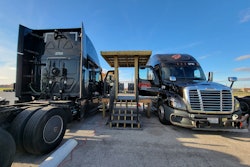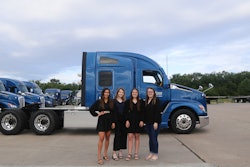CCJ will crown its 2024 Innovator of the Year Thursday night at its Innovator Summit in Key Largo, Florida. Below is a round up of CCJ's 2023 Innovators, each a candidate for the honor of 2024 Innovator of the Year.
As part of its Innovators program, CCJ profiles a fleet each month for deploying – and in many cases, developing – innovative strategies and/or technologies that improve the operation of their business in some area (or areas); be it in recruitment and retention, maintenance, back office technologies and anything (and everything) in between.
Tulsa, Okla., carrier Melton Truck Lines was the 2023 Innovator of the year.
The CCJ Innovators program is sponsored by Bestpass, Chevron Delo, Comdata and Freightliner Trucks.
If you know a carrier that has displayed innovation, contact CCJ Chief Editor Jason Cannon at [email protected] or 800-633-5953.
The Airbnb of trucking
An ongoing challenge Ryder (CCJ Top 250, No. 14) and thousands of fleets across the country battle is idle equipment. Ryder let that common problem serve as unifying call to action when they launched their vehicle sharing platform COOP in 2018.
Now a dedicated website and app has become so popular that COOP has seen 250% year-over-year growth since rolling out four years ago.
Their growing online presence, which Ryder likens to Airbnb, is not only helping Ryder itself to rent more of its equipment it’s also helping more than 10,000 fleets across the country generate revenue from trucks, trailers and vans that otherwise would be sitting around unused. COOP customer Phil Sneed, president of Sneed Leasing in Austin, Texas, said COOP has helped put more of his 53-foot dry van trailers to work.
Custom nextgen in-cab driver experience
Rather than deploy an off-the-rack driver workflow application from its ELD vendor (Platform Science), Murfreesboro, Tennessee-based FirstFleet developed its own using the vendor’s software development kit (SDK), building and deploying a customized application. FirstFleet Chief Information Officer Austin Henderson said the intent was to reduce driver frustration, increase their overall quality of life, increase the quality of the information we get from our driver workforce and increase the quality of communication between the driver and dispatch team members.
When picking up a trailer, for example, the Android-based workflow application sends the driver a screenshot of the customer’s sample bill of lading (BOL) with an arrow pointing to the BOL number. The application knows what format the BOL number the customer or bill to authority uses. For example, if the BOL number is nine digits, the application won’t let the driver enter 10 digits. Drivers previously entered information into a generic workflow form that wasn't load- or customer-specific. In some instances, Henderson said drivers were given the opportunity to enter the temperature of a refrigerated load while pulling a flatbed. FirstFleet services about 20,000 orders a week, processing several hundred thousand driver interactions through the workflow application weekly, so redundant questions or questions not applicable to the load quickly become cumbersome and useless information.
Automated workflows slash error rate
Des Moines, Iowa-based fuel hauler Solar Transport, which has about 220 drivers and 120 trucks serving the Midwest and Rocky Mountain regions, was on track to hit almost $2 million in fuel delivery errors in 2022, said Director of Driver Services Jason Jones.
Industry studies regarding tank-truck usage patterns across the U.S. show that the unintended mixing of octane types at a fueling site happens once in every 14,000 deliveries nationally. A diesel/gasoline mixup occurs once in every 45,000 fuel drops across the country, according to information compiled in a 2021 Civacon case study of R.B. Stewart Petroleum Products Inc.’s use of the CivaCommand Smart Tank System.
Solar Transport made 126,713 deliveries in 2022. While Solar Transport continues to seek ways to further reduce errors, it has seen a 52% decrease in cross-drops and a drop in turnover from 56% to 23% since implementing customized automated workflows.
Walmart's first in-house app its highest rated tech tool yet
Carol Nixon, who after driving for Walmart for roughly nine years, recalled using three out-sourced driver workflow apps that missed the mark.
“Some of the other programs we used before were so not compatible with what we needed to do. It was frustrating. You’d spend more time messing with it and having to pull over to get it right,” said Nixon who as driver since 1990 has seen her share of paper and computer-based workflow systems.
Time lost on the road to app issues kept adding up to less pay for drivers and less than ideal delivery times. Following successful pilots at local and regional levels, Walmart rolled out its NTransit driver workflow app last June to its entire private fleet of 13,000-plus drivers. The app, loaded in a tablet that's mounted in the cab, uses telematics-focused Platform Science as its operating system. Also following NTransit's deployment, dwell times have dropped 13%, product deliveries are more timely, communication has greatly improved and they have near real-time data on their equipment and products.
ArcBest mobile platform boosts visibility, slashes load/unload time
Trailers are typically unloaded piece-by-piece, requiring dozens of trips in and out of the trailer and the touching of various pallets multiple times. Then there's all the manual work inside the trailer, placing load bars and securing pieces of freight, and all of it happens while a driver is waiting and the truck is parked – a process fraught with congested docks, damaged freight and driver dwell time, which increases processing times, customer claims and detention fees.
Just before the pandemic, when supply chain inefficiencies shined brightest, ArcBest (CCJ Top 250, No. 18) kicked off a pilot aiming to improve freight handling, reduce damage and enhance working conditions in its own facilities – a multi-piece suite of hardware and software that modernizes and transforms how freight is loaded, unloaded and transferred, called Vaux. Vaux enables the contents of a trailer to be unloaded in a handful of seconds and offers total visibility into freight movement within warehouse facilities, on the dock and over the road, creating efficiencies and orchestrating seamless warehouse operation.
Program recruits new drivers from within
Brakebush Transportation’s new Driver Finishing Program recruits employees from other areas of the business to become drivers. The idea for the Westfield, Wisconsin-based carrier’s new driver recruitment strategy came about in 2018 in an effort to fill more seats amid a driver shortage, but despite that ongoing industry dilemma, the program came to a screeching halt before it ever got started when COVID-19 hit, said Brakebush Transportation General Manager Mike Schwersenska. The pandemic led the company to shift its priorities to keeping the drivers it did have safe.
The program – still in its infancy – has had a 100% retention rate so far.
FedEx improving LTL shipping
Cutting costs while improving efficiency and sustainability. Those are the core goals of FedEx Freight’s less-than-truckload (LTL) Space and Pace pilot, which continues to deliver encouraging results since rolling out to select customers last November. New technology at FedEx Freight (CCJ Top 250, No. 1) paved the way for dimension-based pricing for LTL which avoids the complex freight classifications under the National Motor Freight Classification (NMFC) system. Published by the National Motor Freight Traffic Association (NMFTA), NMFC is used voluntarily by shippers and carriers to help negotiate shipping costs by comparing commodities transported through interstate, intrastate and foreign commerce.
Customers in FedEx Freight’s Space and Pace pilot can streamline their shipments without having to spend time hunting down and verifying codes. In essence, there’s no longer a need to classify freight because pricing is tied to the Space and Pace the customer needs to move freight.
Days of work cut down to minutes
Household goods moving is a labor intensive, high-touch operation, and if the shipper isn't moving directly and immediately into their new forever home, carefully unloading their entire life into a warehouse – and storing it for weeks or months at a time before re-loading it into a truck for final transport – is a delicate logistical dance.
Budd found a partner in Kentucky Trailer willing to roll the dice in what at the time was a wild idea: essentially an articulated intermodal container-like system the company called Load It Once. There are six steps of handling when household goods come into storage. Because Load it Once slashes the number of times movers have to touch a homeowners' items, it virtually eliminates damage claims in an industry with claim rates of nearly 98%.
The rig consists of two 28-foot pup-containers, each capable of holding upwards of 15,000 pounds, with one affixed to a straight truck and another on a trailer behind. The entire configuration is modeled after EPA guidelines for fuel efficiency and aerodynamics.
Cutting the cord
Aim Transportation Solutions in 2018 created a software system it called RescuePro to help manage equipment breakdowns. When a driver calls into the company's Road Rescue team, RescuePro documents the process. RescuePro over the past 5 years has become the basis of Aim's entire Road Rescue operation, and over that time the makeup of Aim's customer base changed. Transportation became more culturally diverse, and a new generation of customers gravitated away from picking up the phone to make calls.
The company is now rolling out a bolt-on feature with Navigator, Aim's mobile app, enabling drivers to communicate with the Road Rescue team through the app via text. Person-to-person communication is challenging when not everyone speaks the same language. With a customer base as large and diverse as Aim's, RescuePro was designed to interface with Google Translate for non-English speaking customers.
Averitt's 'surgical' approach to pricing
Cookeville, Tennessee-based Averitt Express (CCJ Top 250, No. 22) recently went live with its ExactRate dynamic pricing engine, following three to four years of development in conjunction with the Averitt IT and pricing team and LTL technology solutions provider SMC3.
ExactRate is not based on any rate tariff. It generates a single net charge for the shipment plus line-item charges for any applicable accessorials. Shippers’ freight audit and payment processes must allow for a net, dynamic rate (no tariff/discount breakdown, no line-item fuel surcharge).
ExactRate evaluates Averitt’s estimated costs and real-time demand to provide accurate and serviceable rates that align with market conditions and accurately reflect operational costs.
DHL partners with Girl Scouts
DHL (CCJ Top 250, No. 30) has taken its youth movement efforts several steps further, setting its sights on Generation Alpha – the current generational crop whose oldest members are barely 10 years old. In a partnership with Girl Scouts of the USA, the two groups are establishing a program and branded patch to empower Girl Scouts to learn about the importance of the supply chain industry and discover a myriad of careers in the field.
DHL Supply Chain President of Transportation Jim Monkmeyer said his company is supporting the development of the curriculum by providing logistics experts and knowledge to help craft content for four activities the Girl Scouts will complete to earn the Logistics Patch.
Garner Trucking puts its money where its mouth is
At Garner Trucking’s Findlay, Ohio, terminal, there is a truck changing station where drivers can park a truck on each side and walk straight across from one truck to the other as they move their belongings between the two instead of having to climb up and down the stairs of each truck carrying items in their arms, creating a fatiguing and potentially hazardous situation.
This is just one purchase the company’s driver advisory board has made in recent years, backed by a budget the company allots the board to make moves that improve driver quality of life.
The company’s driver advisory board is made up of six drivers – with room for a seventh right now – that meet on a quarterly basis in person half the time and via Zoom the remainder. The board is also called upon when the company is considering things like implementing a new technology or policy. Each member serves a two-year term before finding their own replacement, including the chairperson. This keeps things fresh with new ideas circulating. And when an idea is presented to the board – whose members are also tasked with keeping contact with fellow drivers for their input – he said a lot of discussion and consideration comes into play before the board votes on a new measure.












